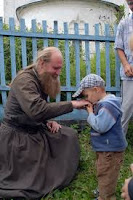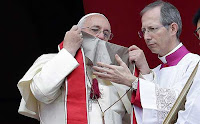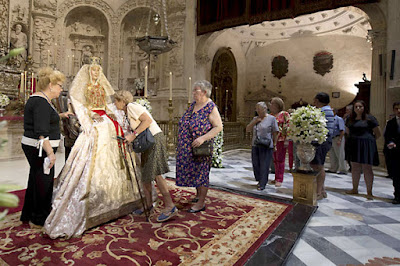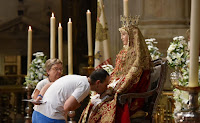 Today we shall share the new chasuble we've made for Father Michael Sahdev. You may remember the red one from a couple of years ago ... memorable because of it's dragon-slaying Archangel enshrined within the pommel of the 3D chalice embroidered on its breast... if you don't, check it out here.
Today we shall share the new chasuble we've made for Father Michael Sahdev. You may remember the red one from a couple of years ago ... memorable because of it's dragon-slaying Archangel enshrined within the pommel of the 3D chalice embroidered on its breast... if you don't, check it out here.
That embroidered chalice has caused much sensation - one day, we've pledged, that design must be realized in real silver and gold... so the real blood of The Lord it may hold - but so far, it sees a second incarnation in this new chasuble too. At least in the tiniest of ways... but ever so present:
The choice was obvious when we discussed some design or theme for the planned white vestment. Doing the chalice again seemed like a good way to have a link between the first chasuble and the new one... but why merely copy? What about placing it on the altar? Have Jesus Himself as priest and Sacrifice.
But we had also discussed incorporating some blue... a nudge to Mary. White vestments are used for the Marian Feasts as well as the Baptisms, Weddings, celebration of non-martyred saints, and of course: Easter, Christmas and All Hallows' Day.
 Standing at 6'6" tall, that's a lot of fabric in a gothic chasuble... so we needed something more than plain white fabric... something with a large enough pattern, enough body to stand and drape gracefully, and this pale silver and gold floral brocade which would have been at home in a 17c painting fell from heaven, as it were.
Standing at 6'6" tall, that's a lot of fabric in a gothic chasuble... so we needed something more than plain white fabric... something with a large enough pattern, enough body to stand and drape gracefully, and this pale silver and gold floral brocade which would have been at home in a 17c painting fell from heaven, as it were.
A royal blue lining was that touch of Mary... yet... finding the electric blue brocade interwoven in silver and gold had everyone in jubilant expectation of seeing what could become of all these seemingly disparate parts. Like a rhapsody: it is episodic, contrasting, capriciously majestic, and extravagantly blue. Could we give it any other name?
You know it had to be what it is: The Rhapsody in Blue Chasuble.
But beyond the obviously external, the evident even from the farthest pew in church... it is also a deeply special and intimate homage to the inspiration which fills the breast of the priest who wears it:
At the center, as we already saw, is the chalice with the blood and the flesh shining above: Jesus as the sacrifice and priest at once. God sacrificing Himself to Himself. Something every priest remembers when re-enacting that first mass.
To his right is the precursor Saint John the Baptist, His cousin, who recognized Him even when each was still within the womb of their mothers... and speaking of Mary Full Of Grace, she stands behind, supporting the fruit of Her womb, with a hand on His shoulder.
John, of course holds a silver shell as those used to baptize... for lest anyone forgets, he was not only the one to sprinkle Jesus with the waters of The Jordan, but also His cousin... and cousins seem to always hold bunny ears or some such in pictures, if they can - do they not?
So, the raised arm in the gesture of baptizing is our way of remembering that even in the most serious of subjects there should be mirth, for after all, The Agapeic Meal is a heavenly sight and nothing to frown over, solemn as it is.
Mary, all the while, holds a candle.
 This recalls Jesus being called "Light of the World" and also a nod to her Churching, also known as The Purification of Mary (February 2nd, 40 days after The Christ's birth). In some of the Romance languages birthing is equated with the mother "giving light" to her child: "dar a luz" in Spanish and Portuguese. Sometimes they also gift chasubles (Hi Pam!).
This recalls Jesus being called "Light of the World" and also a nod to her Churching, also known as The Purification of Mary (February 2nd, 40 days after The Christ's birth). In some of the Romance languages birthing is equated with the mother "giving light" to her child: "dar a luz" in Spanish and Portuguese. Sometimes they also gift chasubles (Hi Pam!).
Family is thus here represented. It was, after all, the mother and the aunt and the cousins of Father Michael who invested him with his own first chasuble the day of his ordination. Something to remember not just when wearing that special red chasuble, but also this white one on ever more happy occasions to come.
Speaking of inspiration, the other two figures represent the patron saints of the most important parishes in which the priest in question has served: Saint Benedict of Nursia, in his monastic habit represents his childhood parish, and church where he said his first mass. The confessor kneels opposite Saint Philip The Evangelist, who had been one of the original Seven Deacons in Jerusalem, and is the namesake of the church where Father Michael says mass now.
 |
| Detail of the Kissing Cross on the Priestly Stole. |
So there you have it. From the broadest sight to the smallest of details; for the farthest spectator to the most inquisitively near-sighted inspector: The Rhapsody in Blue chasuble should be as good as any other instrument in the work of evangelizing those who should wonder or ask "why the blue?" or "what does the little cup mean?".
When everything has a reason, and the logic is ever to point to the source and ends of all... we should be satisfied that a good thing has come to be. And so, it is. The design, from the mind, onto the paper and into the stitches in thread, now too: is as it ought - put to the good service.
























































































